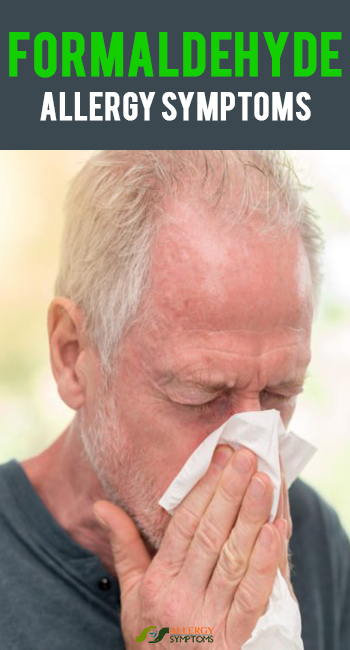Formaldehyde is a flammable chemical substance used in manufacturing various products, including vaccines, house hold items and wrinkle free fabrics. It is used extensively in our daily life, but sadly this colorless gas has a dark side. Repeated exposure to this strong smelling chemical may trigger uncommon symptoms.
In the year 2015 American Contact Dermatitis Society declared formaldehyde has Contact Allergen of the year.
When irritants in this chemical come in contact with the body, your immune system releases antibodies to identify harmful substance. When the immune system receives the signal about harmful ingredients, it releases histamines to combat them. Histamines react with these foreign materials and results in formaldehyde allergy symptoms.
It’s not easy to list all the substances that may trigger this allergy. Below listed are few common sources of formaldehyde.
- Household items like cleansers, polishes and disinfectants
- Wooden furniture, plywood
- Paints, paint-strippers and primers
- Burning wood, coal, cigarettes and kerosene releases this gas in smoke
- Water resistant paper
- Cosmetic cream, nail polish, shampoo, deodorants etc…
- Wrinkle free fabrics
- Medication for warts and some medicated creams
- Building materials
- Root canal dis disinfectant
Formaldehyde Allergy Symptoms
Signs or symptoms of this allergic reaction depend on the type of the exposure. Some of you may experience this reaction even with small amount of formaldehyde. It’s not necessary that an allergic reaction should trigger as soon as you inhale or come in contact with it. The allergy reaction takes time and symptoms appear as you get exposed to this chemical repeatedly.
Prolonged exposure to formaldehyde may cause hypersensitivity which in turn may lead to contact dermatitis. This is the result of being in contact with formaldehyde present in clothes, skincare products, nail polishes etc. If you have suffered with contact dermatitis then the allergic reactions can spread to other parts of the body as well.
Mild symptoms of formaldehyde allergy are:
- Burning sensation in eyes
- Runny nose
- Irritation in throat
- Coughing
- Watery eyes
- Blurred vision
- Wheezing
- Skin rash
- Contact dermatitis
- Eczema
Severe symptoms include difficulty in breathing, asthma and fainting. These signs are very dangerous and need immediate medical attention.
Other symptoms include:
- Abdominal pain
- Vomiting, nausea
- Migraine headache
- Diarrhea
How to Treat?
Unfortunately, there is no precise treatment for curing formaldehyde allergy. It’s best to prevent than cure. To avoid any allergy, you must avoid contact and consumption of that particular item. In this case it’s nearly impossible to avoid items with formaldehyde, as there are huge list that we use in our daily life.
If you experience allergic symptoms over the skin, immediately wash it with water and apply antiseptic or moisturizing cream. Food with this chemical ingredient must be limited or combined with other items to reduce its effect. Coming to steroids, you must consult doctor before using them.
How To Avoid Formaldehyde Allergy?
It is difficult to avoid formaldehyde completely as it is present both indoors and outdoors. But most of the time it is present in low levels and it may not effect many people. However following are some of the measures to avoid such allergy.
- Cloths made up of 100% cotton, silk, nylon and polyester contains very less amount of formaldehyde. Try to wear such clothes only.
- Make the purchase of furniture that are made of pressed wood products and the surfaces and edged should be laminated or coated.
- Always wash new clothes in hot water before using them.
- In order to avoid formaldehyde when indoors, open up the windows and ventilation and you can even install exhaust fan in a closed space.
- Read the label of products carefully before making purchase.
Other Names of Formaldehyde

Formaldehyde is also known with different names, if you are allergic to it then you must be aware of these names and make your purchase wisely. The names are as follows
- Oxymethylene
- Methyl aldehyde
- Morbicid acid
- Methanal
- Methylene oxide
- Formalin
Sources of Exposure to Formaldehyde
- Cosmetics and toiletries
- Pressed wood products and plywood
- Canned ice
- Cleaning agents and disinfectants
- Textiles and fabrics
- Glues
- Polishes
- Printing material
- Tanning agents
- Mildew preventatives in vegetables and fruits
- Paper products
- Cellulose esters
- Embalming fluids and fixatives
- Certain medications
- Rubber and cement
- Photographic plates
- Urea plastic present in footwear, buttons and jewellery
What is your take on formaldehyde allergy symptoms?

